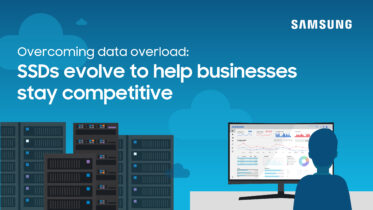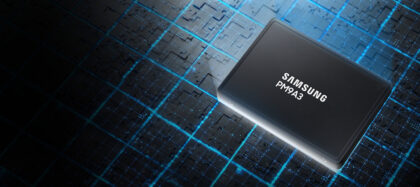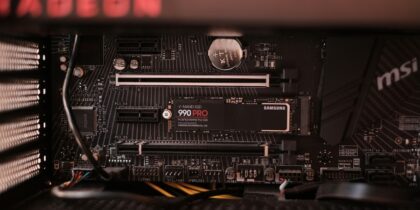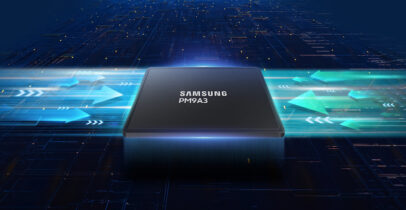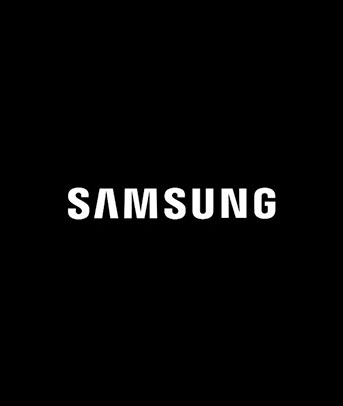A crucial part of your IT infrastructure is your enterprise storage subsystem — whether it’s on a single server and desktop or 1,000. In choosing hard drives, solid state drives (SSDs), consumer drives, enterprise storage components and capacities, you have a ton of options, so you’re bound to find a solution that fits your needs. But what types of buses and protocols are those storage devices using? And when should you aim to equip your machines with which types of devices?
Storage interfaces connect the actual drives where your data resides to your system’s main processing bus. Think of the interfaces as the highway that data travels on to get from your drive to your processor and memory.
Today, there are two main types of bus interfaces in most PC production systems: serial advanced technology attachment (SATA) and peripheral component interconnect express (PCIe®). Each has its own history, design and proper placement.
Bus interfaces: A brief history
SATA is a computer bus interface designed at a time when hard disks were dependent on spinning platters and therefore had a relatively low physical limit on how much data they could transfer at once. Looking at computers — and especially servers — from the early 2000s and before, no matter how powerful your processor was, the most common performance bottleneck was the hard drive. SATA protocol may have been designed to speed up storage transfers on this slower medium, but it was still designed for spinning media. Its latest version, SATA 3.0, dates back to 2008 — well before SSDs became mainstream.
Prepare for your storage upgrade
Which form factors and interfaces make the most sense for your company's storage needs? Download Now
Then SSDs arrived, eliminating the need to seek individual sectors on a spinning platter and offering rapid data retrieval and transmission. SSDs could handle sustained data transfer rates at an order of magnitude faster than spinning media. So SATA data transfer limits became reality. Modern motherboards use the SATA III interface, which can handle 600MB/s. Older motherboards may use SATA II, which tops out at 300MB/s. These systems are all but obsolete and should be replaced.
Next came the non-volatile memory express (NVMe®) protocol. More than anything, NVMe is designed for speed. It eschewed the common command sets, SCSI and ATA, instead using its own commands and protocols to transfer data between a fast storage device, like an SSD or a super-fast cache memory, and a host system over the PCIe peripheral bus.
Drive speed and capability depend on your specific drive and controller combination. But for the sake of comparison, a 7,200 RPM SATA drive can typically drive around 100MB/s in throughput (depending on how old the drive is, if it’s in good working order and if the disk is relatively contiguous and not too fragmented). Contrast that rate with NVMe drives, which can boast write speeds as high as 3,500MB/s. As a result, you can expect NVMe drives to perform five to seven times better than SATA SSDs, and at 25 to 35 times the speed of your legacy-style spinning media.
NVMe was built in the era of fast solid state storage and it doesn’t try to be backward-compatible. It’s a storage protocol designed for the future. According to T41, 280 million units of SSDs were shipped worldwide in 2019. Shipments are projected to grow 18 percent in 2020, and it won’t stop there. As SSDs become increasingly popular, NVMe will become increasingly important.
Pros and cons: SATA vs. NVMe
Choosing the right storage interface bus can be the difference that gets you the right workload solution that meets your needs for both performance and cost. Here’s a handy guide to the advantages and disadvantages of SATA and NVMe.
Advantages of SATA
- SATA has a long history of support on different hardware and form factors, so it has remarkable compatibility with a variety of devices from the early 2000s to today.
- SATA devices are relatively inexpensive because they’re widely available and have lower performance levels than spinning media.
- SATA is preferable for workloads where low cost for larger capacities is the main priority — for archiving data, storing little-used files and keeping backup solutions — and transfer speed is a secondary or tertiary concern.
Disadvantages of SATA
- It’s the slowest storage transfer protocol, designed for yesterday’s storage devices, not tomorrow’s.
- Some M.2 devices still use SATA connectors and command sets, and they perform much more slowly than their NVMe counterparts. The format can cause confusion during device selection.
- SATA and its related devices are ill-suited to busy, data-intensive environments that depend on fast transfers and low latency.
Advantages of NVMe
- Less time is required to get data from storage medium to host processor, making NVMe a much better choice for data-intensive applications and workloads.
- The NVMe protocol has much lower latency, allowing for better-performing sustained transfers and more consistent data delivery.
- The M.2 format used by many NVMe devices allows for great capacity in a tiny form factor — such as a thumb drive — perfect for systems that require fast performance and a lot of storage where physical space (or perhaps device weight) is a limiting factor.
Disadvantages of NVMe
- NVMe depends on relatively high-performance SSDs that are more expensive than spinning drives on a capacity basis.
- For client PCs, NVMe generally depends on devices in the M.2 format, which limits the drive selection compared to other solutions. (U.2 drives, with a 2.5-inch form factor, are very relevant in the data center space.)
- There isn’t much support for legacy NVMe on older systems, making a storage system upgrade unlikely for an otherwise serviceable machine.
- NVMe devices, while gaining overall value every day, aren’t the most cost-effective choice for storing large amounts of data in your archives.
Discover how over-provisioning SSDs can improve memory performance in this free white paper.
1 T4. “SSD Market Share.” January 23, 2021.


